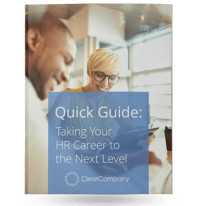In the HR world, and within the workplace, learning something once isn’t good enough. In order to ensure that your A Players stay on top of their game, continuous learning must be a driving factor. And, as an HR leader, it is important that you provide learning opportunities to all employees, including HR who are often overlooked in these types of initiatives. Unfortunately, this continuous learning can be put on the back burner because the overall HR budget has a historical median of only about 1%.
Ready to take your HR Career to the next level? Download this resource to help guide you:

So, check out the list below to help ensure that the most important information concerning your company is covered and distributed to any and everyone who needs it:
Safety First
Few people find workplace safety requirements a thrilling topic, however they are absolutely necessary.You don’t need a harsh environment to cover workplace safety. In 2015, there were approximately 2.9 million nonfatal workplace injuries and illnesses. And, the category of safety acts as a huge umbrella to cover things from parking lot protocol to weather drills and cybersecurity. Depending on your industry, these courses or overviews need to cater to appropriate concerns and situations.
 Workplace safety policies aren't everyone's favorite. How to excite your team to engage:
Workplace safety policies aren't everyone's favorite. How to excite your team to engage:
To get started, consider these courses from the National Safety Council.
Courses such as these help to reduce not only workplace injuries, but also liabilities while ensuring that everyone is trained and well informed so that they too can be held accountable for their actions.
Workplace Environment
As an HR leader or manager, it is your duty to ensure that procedures and workplace protocols are adheared to. This includes, harassment, equality, and anything else that may create a hostile work environment. From workplace bullying to a social media policy, the recent Google manifesto drama serves as a stark reminder to us all, that HR professionals need to stay abreast of what constitutes a hostile work environment and how we can guard against harassment and preserve free speech.
 #HR pros, do you know what constitutes a hostile work environment? Read this before answering:
#HR pros, do you know what constitutes a hostile work environment? Read this before answering:
However, when you take the time to properly train your team, you reduce liability, and ensure a safe, comfortable, and enjoyable environment for your employees. For various courses concerning the different types of workplace environment issues check out some of these sources:
The Office of Justice Programs and Office for Civil Rights works to educate under the laws of safety and and the right of employees, stakeholders, and more by focusing on innovation and partnerships.
HHS provides insight into health information privacy for the workplace by helping entities implement privacy and security protections. These training focuses on HIPAA regulations and resources for the benefit of your workforce.
The Security Standards Council partners with PCI for training awareness on data and information security. This includes fields such as the Internal Security Assessor and Approved Scanning Vendor programs.
NAVEX Global’s seventh-generation Workplace Harassment course are the industry-leading training solution for employees and managers. These programs help provide an overview to limit liability and HR interference so the companies can maintain a cohesive, well-rounded workplace.
Customer Service
Your HR employees may not deal directly with customers, but they should be treating their candidates just like customers. This means putting their needs first, treating them with respect, and working to solve any issues they may be having. It’s been found that roughly 96% of customers or clients do not voice their complaints. This, is where the importance of training comes in.
 #DYK 96% of customers & clients don't voice their complaints? How to prepare your teams for this:
#DYK 96% of customers & clients don't voice their complaints? How to prepare your teams for this:
Mastering the ability to handle every interaction with grace and integrity is even more essential to your business when you deal with high level clients, or are attempting to get the attention of new candidates. Lucky for you, there are plenty of resources both you, other managers, and your employees can use to ensure that their conversations and interactions are benefiting your company and the client/candidate at hand.
For a free course that helps to address the many unique and challenging situations employees may face, take a look at Alison.com. Customer service training is slowly being the purview of every department, with client/candidate interactions dictating buyer or even hiring decisions and influencing brand reputation. To this end, every employee should be trained on how to respond to complaints, concerns, frustrations and questions. Other resources include HelpScout, ZenDesk, and The Balance.
For HR specifically, there are two key areas that many teams are looking for refreshers on these days:
Analytics
If you’re in HR, not only are you dealing with the issues and regulations mentioned above, but hiring and recruiting are most likely a part of your tasks as well. Sometimes, it’s your job to find the best hires so managers and supervisors can take the lead to move along in the process. And, what better way to make your job a little easier than by having an understanding of analytics and analytic tools, like machine learning, that help you match skillsets, identify new hire training needs, and so much more.
HR analytics provides you a way to do all that and more with the possibility of an 8% higher sales growth and a 24% higher net operating income. Unfortunately, many HR teams lack the insight on what and how to track in order to gain these great benefits.
In order to understand the complications of data and analytics, or to see what processes might need a refresher, consider starting with a self-assessment. This one from Kaggle is a great way for you to see where your HR department needs help to better understand analytic applications and data.
If you don’t have a system that tracks analytics or metrics for you, you may want to expand your learning so you can see what works best and what options you have. This can be invaluable when it comes to getting additional budget to fund initiatives, building out and vetting additional software or creating succession and recruiting plans during critical seasons like M&A, high-growth, or expansion plans into new markets.
Since technology and metrics software are always changing, we recommend taking courses quarterly instead of yearly. This will make make sure your entire team understands the best way to find the perfect hire and the best way to help managers train them for maximum ROI. Here are some resources for your team to check out:
Technology Trends
Speaking of technology and making jobs a little easier, HR technology can revolutionize how your team gets work done. But, in order to get the most out of your systems, you have to stay up-to-date on advancements in the industry. Being more familiar will help you and your team work more efficiently, while also being more productive and engaging with co-workers and employees from other departments.
For some of the latest insights on what specific HR technologies can help you, take a look at Lynda or Coursera. These two resources will provide an inside look on how certain technologies work and what you can do to implement them in your own workplace. Of course, organizations that cater to HR Professionals allow you to take courses specifically focused on HR. Some of the most respected organizations and education repositories include:
SHRM- Society for Human Resources
HRCI- Human Resources Certification Institute
Want to really make sure your HR department is prepared and informed? We have just the thing! Register for our Talent Success Conference to get insights from industry leaders including retention, engagement, onboarding and more!
Recent Posts:
.png)


